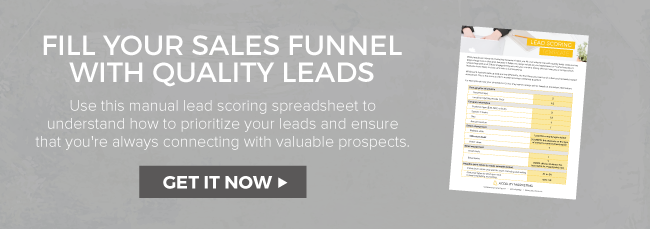We Need to Talk About How Your B2B Sales Team Handles Qualified Leads

It’s no secret that your sales and marketing teams don’t always see eye to eye (that’s why I previously wrote about the importance of aligning these teams). I’ve seen firsthand that many sales teams think the leads from Marketing are garbage—and they could be right (if so, that’s a different issue).
However, if your marketing team has an effective strategy in place, it’s time to stop the blame game and start looking at how your B2B sales team is handling quality leads.
Why are leads being mishandled?
As a former salesperson I can safely say this is all about education. If your sales team is young (many salespeople are young professionals), you’ve likely taught them about your product and company, and trained them on how to cold call and handle meetings. The Marketing and Sales lead hand-off is often discussed as a bullet point during a larger meeting about selling.
This is a mistake.
But don’t worry—the gaps in education are easily addressable. Below are a few places to start:
- Sales isn’t reaching out soon enough
- Sales is not following up enough
- Sales is treating the leads like a regular call
- Sales thinks marketing leads should be made of magic
1. Sales isn't reaching out soon enough
Has your sales team ever been notified of a qualified lead, then just sat on that lead? (Be honest, you probably answered “yes”.) This is all too common, and frankly, they’re losing you money.
When they finally do reach out to the lead, they’ve cooled. In fact, every day Sales doesn’t reach out, the effectiveness of converting a qualified lead drops by 15%. Yikes!
What happens next? Sales complains that the lead didn’t go anywhere, and the burden is put back on the marketing team (trust me, I’ve been one of those complaining voices).
How you can fix this: When Sales has a qualified lead from Marketing, multiple sources say follow-up should happen within 10 minutes. Educate your sales team on that timeline, and work with Marketing to make sure you have the proper systems in place to automatically send qualified leads to Sales quickly.
2. Sales is not following up enough
Many B2B sales reps just don’t have good follow-up strategies in place. Some just want to get their dials in for the day and don’t care who they call. Others just give up too soon. Either way, you need to educate your sales team as to how many times they should reach out before disqualifying the lead. Keep in mind that 80% of qualified leads take more than 4 touches to close.
How you can fix this: To increase the likelihood of connecting with a qualified lead, many inbound sales and marketing sources say you should make 6-10 attempts to reach out to qualified leads before moving on.
Give your sales team a set cadence that they can follow for their outreach (if you don’t have one, best practices for sales cadence can be found in this resource). This way your team will stay consistent across the board, and if they have issues with qualified leads, you can check their efforts against the cadence to make sure they are reaching out enough.
3. Sales is treating the leads like a regular call
Because some sales reps have the mindset that qualified leads are junk, they don’t treat the leads any differently than the 40-120 calls they have to make that day. This is a no-no. These leads interacted with your content (which is a big deal!), so treating them like Joe Tuesday isn’t going to win them favor. In fact, it can actually turn the lead off completely when someone from Sales acts like the lead has never heard of the company before, when they were just on your website. What’s more, it makes your company look bad.
How you can fix this: Make sure your sales team does research on how the contact engaged with your marketing efforts before they reach out. If someone downloaded a piece of content, they shouldn’t avoid talking about that fact (I know it can seem very “Big Brother is watching you”, but it’s not.). In fact, referencing a piece of content is a great way to start a conversation—a simple, “Hi Karen, I saw you downloaded our piece on X. I wanted to reach out and see if X is a challenge/goal for you right now. If now’s not a good time, when could we chat about it?” can go a long way.
4. Sales thinks marketing leads should be made of magic
Listen, I know I’m being hard on sales people, but I wouldn’t be saying this if it weren’t true. As I previously mentioned, I was in sales, so I have firsthand experience with this issue. Sales expects a lot of marketing, and rightfully so. However, your sales team should not expect these leads to be layups, or that Marketing is going to do all their work for them. They are warm leads, not scalding hot prospects.
How you can fix this: Set realistic expectations with your sales team on the likelihood of these leads closing. Also, refer to points 1, 2 and 3 of this blog to discuss how they can position their calls to have better conversations and when and how often to reach out.
If your sales team is mishandling quality marketing leads, don’t worry—a little education can go a long way (and save your business money). If you have additional strategies related to this topic, I’d love to hear them in the comments below.
If you’re struggling to get your sales team quality leads, you might want to check out our lead scoring template to get you started on the right foot, or contact Milwaukee Marketing agency, Accelity Marketing, to chat through best practices.


